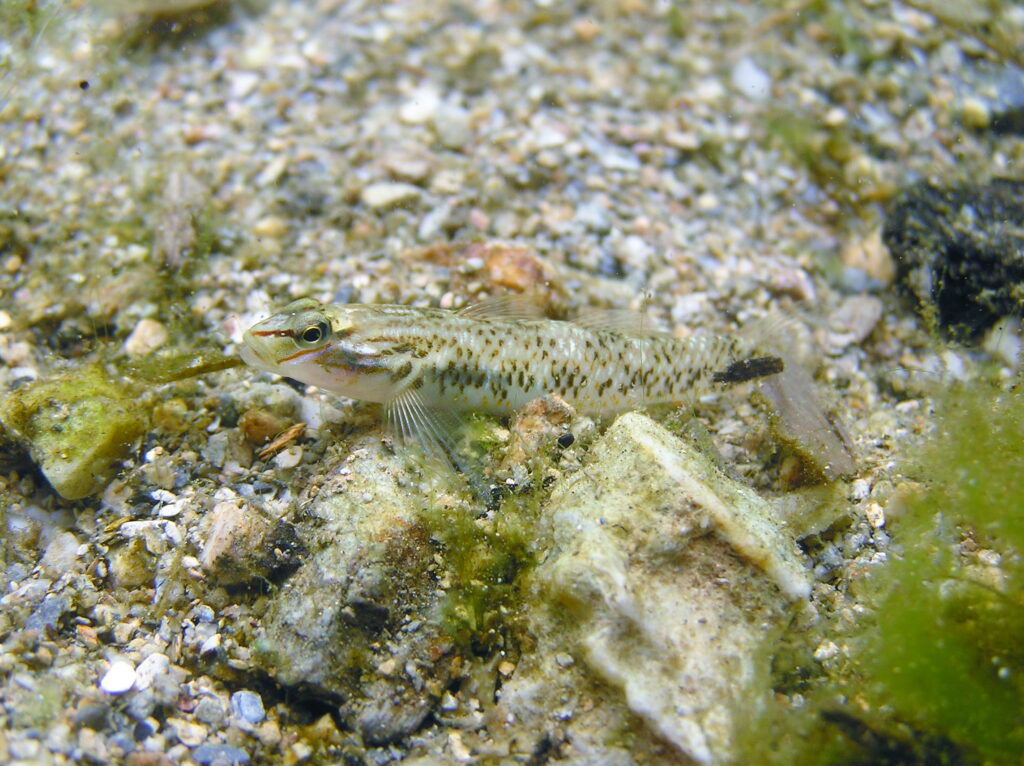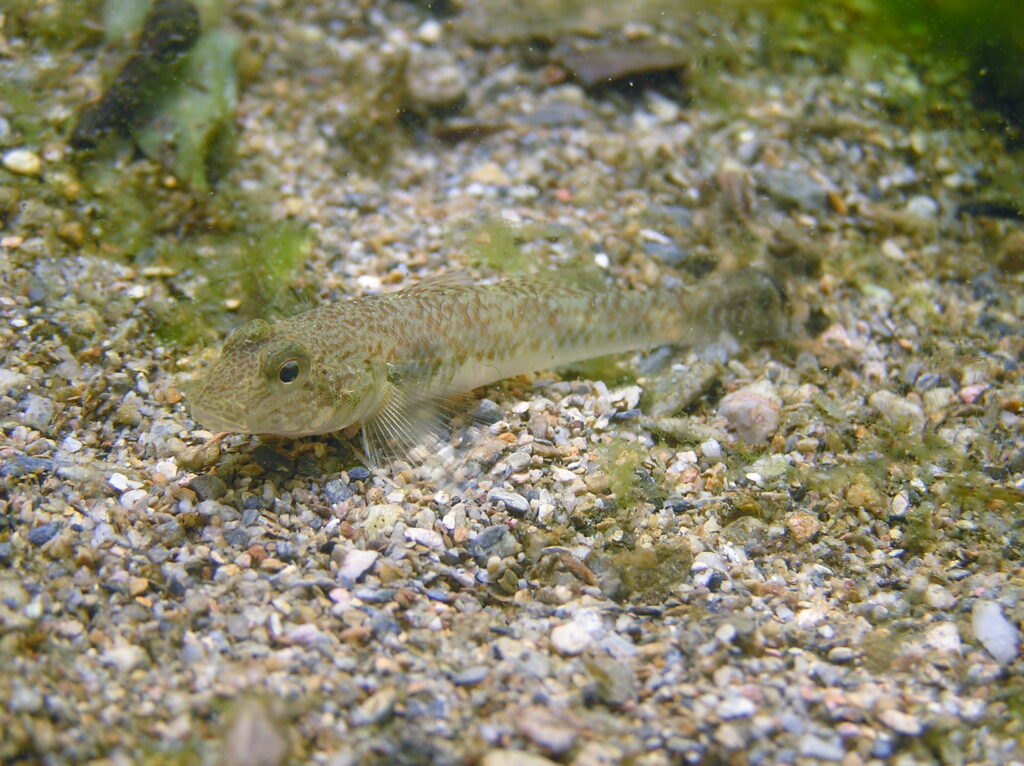Let’s introduce the characteristics and fish fauna of the river flowing through Okinawa Prefecture, the southernmost prefecture of Japan.
River Overview
The Okukubi River is located in the central part of Okinawa Main Island, in the southern part of Japan, with a total length of about 8.0 km. The drainage area is 16.4 square kilometers, and the elevation of the source area is 90 meters. Rivers on Okinawa Island are short, with the longest river being only 12 km, making this 8 km river one of the longer rivers on the island. It begins in the gentle mountains of Onna Village in Kunigami District and flows into the Pacific Ocean. There is a dam, Kin Dam, about 2 km from the lower part of the river.
Downstream of the Okukubi River, there are mangrove forests where kayaking is possible. Also, at the mouth of the Okukubi River, a tidal flat has formed, known as an important wetland in Japan. This area is inhabited by many bird species and aquatic organisms unique to tidal flats, such as fiddler crabs and the southern mudskipper. There are also tours that involve round trips along the Okukubi River on water buffalo carts.
Fish Fauna Characteristics
According to a survey conducted by the government in 2016, 39 species of fish have been recorded in the Okukubi River. Especially in the downstream river, brackish and marine fish are often seen, with many species of the goby family being observed. On the other hand, the only fish that live their entire lives in freshwater are the swamp eel and the carp family, with the latter likely being a non-native species.
There is a significant difference between the fish fauna in the Kin Dam lake and the downstream river. In the downstream river, most are native species, while in the lake, about 70% of the species are non-native. The scarcity of freshwater fish species might be one reason for this. In an environment where migration between the sea and the river is difficult, it might naturally be hard for native species to establish themselves. Moreover, the existence of a huge lake formed by a river only 8 km long may itself be considered unnatural. In other words, within this short course and artificial environment, a fish fauna dominated by non-native species has formed.
Despite the short course of rivers in Japan, many rivers have dams installed. I believe that, although not as evident as this dam, the same phenomenon is occurring with other dams.


The List of Freshwater Fish Species in the Okukubi River
| No. | Species | Life Cycle | Origin | reservoir | downstream |
| Anguilliformes | |||||
| Anguillidae(Eels) | |||||
| 1 | Anguilla marmorata | M | Native | ○ | |
| Cypriniformes | |||||
| Cyprinidae(Carps and Minnows) | |||||
| 2 | Cyprinus carpio | Fr | Introduced | ○ | |
| 3 | Carassius sp. | Fr | native/Introduced | ○ | |
| Siluriformes | |||||
| Loricariidae(Armoredcatfish) | |||||
| 4 | Pterygoplichthys disjunctivus | Fr | Introduced | ○ | |
| Synbranchiformes | |||||
| Synbranchidae(Swampeels) | |||||
| 5 | Monopterus sp. | Fr | Native | ○ | |
| Mugiliformes | |||||
| Mugilidae(Mullets) | |||||
| 6 | Mugil cephalus cephalus | E | Native | ○ | |
| 7 | Chelon macrolepis | E | Native | ○ | |
| Cyprinodontiformes | |||||
| Poeciliidae(Livebearers) | |||||
| 8 | Xiphophorus hellerii | Fr | Introduced | ○ | |
| 9 | Gambusia affinis | Fr | Introduced | ○ | |
| 10 | Poecilia reticulata | Fr | Introduced | ○ | |
| Beloniformes | |||||
| Adrianichthyidae(Ricefishes) | |||||
| 11 | Oryzias latipes | Fr | native/Introduced | ○ | |
| Perciformes | |||||
| Centrarchidae(Sunfishes) | |||||
| 12 | Lepomis macrochirus macrochirus | Fr | Introduced | ○ | |
| Apogonidae(Cardinalfish) | |||||
| 13 | Fibramia amboinensis | E | Native | ○ | |
| Carangidae(Jacks and Pomanos) | |||||
| 14 | Caranx sexfasciatus | E | Native | ○ | |
| 15 | Caranx ignobilis | E | Native | ○ | |
| Lutjanidae(Snappers) | |||||
| 16 | Lutjanus argentimaculatus | E | Native | ○ | |
| Gerreidae(Mojarras) | |||||
| 17 | Gerres shima | E | Native | ○ | |
| 18 | Gerres oyena | E | Native | ○ | |
| Sparidae(Porgies) | |||||
| 19 | Acanthopagrus sivicolus | E | Native | ○ | |
| Cichlidae(Cichlids) | |||||
| 20 | Oreochromis sp. | Fr | Introduced | ○ | ○ |
| Teraponidae(Teraponids) | |||||
| 21 | Terapon jarbua | E | Native | ○ | |
| Eleotridae(Sleepers) | |||||
| 22 | Eleotris acanthopoma | M | Native | ○ | |
| 23 | Eleotris melanosoma | M | Native | ○ | |
| Gobiidae(Gobies) | |||||
| 24 | Periophthalmus argentilineatus | E | Native | ○ | |
| 25 | Callogobius tanegasimae | E | Native | ○ | |
| 26 | Pandaka trimaculata | E | Native | ○ | |
| 27 | Exyrias puntang | E | Native | ○ | |
| 28 | Mugilogobius sp.1 | E | Native | ○ | |
| 29 | Mugilogobius chulae | E | Native | ○ | |
| 30 | Pseudogobius javanicus | E | Native | ○ | |
| 31 | Redigobius bikolanus | E | Native | ○ | |
| 32 | Rhinogobius sp.MO | M | Native | ○ | |
| 33 | Rhinogobius similis | M | Native | ○ | ○ |
| 34 | Favonigobius reichei | E | Native | ○ | |
| Scatophagidae(Scats) | |||||
| 35 | Scatophagus argus | E | Native | ○ | |
| Siganidae(Rabbitfish) | |||||
| 36 | Siganus guttatus | E | Native | ○ | |
| Sphyraenidae(Barracudas) | |||||
| 37 | Sphyraena barracuda | E | Native | ○ | |
| Belontiidae(Gouramis) | |||||
| 38 | Macropodus opercularis | Fr | native/Introduced | ○ | |
| Tetraodontiformes | |||||
| Tetraodontidae(Pufferfish) | |||||
| 39 | Chelonodon patoca | E | Native | ○ | |
| 13 | 28 |
** : While some species have been subdivided, the names of species have been retained as they were previously for comparison with past data.
*** : Salvelinus leucomaenis and Oncorhynchus masou masou are included in the record because the author has confirmed their perennial habitat in the upper reaches of the survey area.
****: Classification of Life Cycles
・ Freshwater: Species that can spend their entire life in freshwater.
・ Migratory: Species that must migrate between freshwater and saltwater during their lifetime.
・ Euryhaline: Species that primarily inhabit brackish or saltwater, but may also venture into freshwater.
However, since there are species with intermediate characteristics, such species have been categorized at the author’s discretion.




コメント